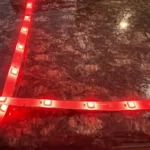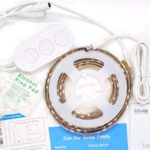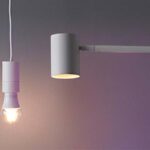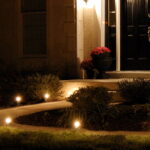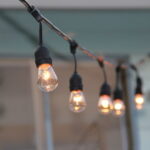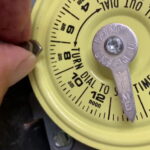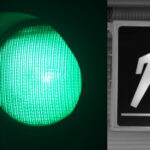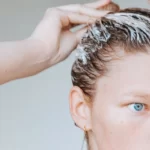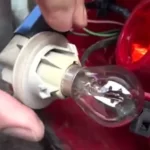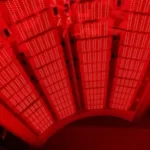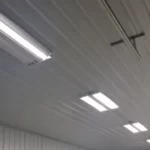How To Get LED Lights Off Wall In An Easy Step?
To start with, how to get led lights off the wall?
Start at a corner or edge piece and slide a flat, dull object (like a butter knife or a credit card) under the LED strip. Use the flat object to gently pry the LED strip away from the wall. Pull the LED strip slowly away from the surface with your other hand at the same time.
Please continue reading for more specific instructions on how to remove led lights from walls.
Table of Contents
Why Get Led Lights Off Wall?
You might want to remove the led lights from the wall for a few different reasons. If you’re moving, you might need to take them down for transport, or you might be remodeling your house and want to switch up the lighting. It’s crucial to remove the LED light from the wall for a variety of reasons.
Required Materials To Get Led Lights Off Wall
- Screwdriver
- Wire cutters
- Pliers
- Safety goggles
How To Take Led Lights Off The Wall
Unpluging The Light Strip And Heat The Adhesive
The LED light strip must first be unplugged from its power source. The adhesive holding the light strip in place needs to be heated after it has been unplugged. A hairdryer or heat gun can be used for this. When the adhesive is melted, move the heat gun back and forth while holding it about 6 to 8 inches from the wall.
Finding An End & Corner
Finding a corner or an end is the best place to start when trying to remove LED lights from a wall. You’ll find it easier to get going and maneuver around the entire light if you do this. Pry one of the lights off the wall at the end or corner using a flathead screwdriver.
Removing The Light Strip
Starting with a gentle pull on one end of the light strip, remove it from the wall. Use a putty knife or another flat object to help pry the strip free if it is stuck to the wall. Peel back the strip section slowly and carefully until it has been completely peeled back from the wall once you have a small section of it freed from the surface. You can buy a new one from a hardware store or online if the strip needs to be replaced because it is broken.
Removing The Mounting Bracket
It’s time to take off the mounting bracket after the light has been unplugged from the power source. Normally, the bracket is secured in place by two screws on the back of the light. These screws should be taken out and stored. Now the light’s bracket will be removed. Scrape off any adhesive from the bracket’s back before storing it someplace secure.
Cleaning The Wall
You’ll need to clean off any adhesive or dirt that might have been left behind after removing the light from the wall. To complete the task, mix warm water, rubbing alcohol, and a rag. Before continuing, make sure the wall is completely dry.
The LED lights can be safely stored away for later use once you have taken them down. However, kindly store them in a cool, dry area to prevent damage.
Repeating The Process
For every light you need to remove, repeat the process. You can clean up any dirt or adhesive that is still present after turning off all the lights, and you can also get rid of the old lights.
Knowing how to remove led lights from a wall means you can do it on your own whenever necessary. Few materials and some patience are all that are needed for the straightforward process. Be careful when peeling the light strip away from the wall and make sure to unplug it before you begin. Then, if any lights are damaged, you can quickly replace them with a new one by going online or to a hardware store.

Ways To Remove Led Lights Without Peeling The Paint
Using a hairdryer to soften the sticky part or a putty knife to carefully pry it off will allow you to remove your LED lights without damaging the paint.
Take care not to scuff the paint. Use a powerful adhesive remover as a last resort if all else fails. To ensure that it won’t remove the paint, test it first in a small area.
Some Common Led Light Strips
LED light strips offer a variety of lighting options for any area. It is crucial to pick the best LED strip for your needs out of the many different types and designs available on the market. Here are a few popular LED light strips:
Minger Led Strip Lights
These lights are well-liked because they are inexpensive and simple to install. They can also be controlled by a remote and come in a variety of colors.
Philips Hue Lightstrip Plus
Although these lights are more expensive, they provide a wider variety of colors and features. They can also be managed through voice commands or a smartphone app.
Phopollo Led Light Strip
For many people, the Phopollo LED light strip is a well-liked option. It is incredibly simple to install and made of top-notch materials. In order to regulate the amount of light emitted, this light strip is also dimmable.
What Kind Of Walls Can Strip Lights Damage?
Let’s face it: interior design is constantly evolving. Your choices and style have changed over the last one, five, or even ten years.
Has anyone else ever begged their parents to let them paint their bedroom a loud color? How do you feel about that choice now?
Most likely, you won’t want the same LED strip lights in the same location forever. How simple is it to take them out after they’ve been anchored?
The type of surface you adhere to determines the answer.
Nothing should go wrong if your wall is made of tile, wood, or plastic. Peeling off the strips won’t damage the wall and they should be fairly simple to do.
If anything, there might be some unwiped adhesive residue.
However, if your surface is painted, wallpapered, or just plain drywall, issues could develop. These surfaces are more vulnerable to damage because they are constructed of numerous thin, fragile layers.
Wallcoverings are ultimately just made of paper. Any type of paper will form a strong bond when strong adhesive is applied. We wrap presents with sellotape because of this!
You’ll have trouble separating the two parts when it’s time to take out your LED strips, though. It’s likely that your wallpaper will rip, ripple, or tear.
If your wallpaper is patterned, this will be especially annoying because any gaps will be very obvious. In a similar vein, you cannot simply paint over the damaged wallpaper to conceal it because it is patterned.
Ever wonder if your strip lights have an impact on your animals? Learn more in my article on dogs and strip lights.
Led Light Strips: Are They Reusable?
LED light strips can indeed be recycled. You must first coil the light strip up and put it in a secure location before you can remove them from the wall and turn off the power. To avoid damage, store the light strip in a cool, dry location.
Imagine you are taking down the LED light strips from the wall and selling them with all the required parts. Aside from the light strip, this also includes the power supply and mounting components.
LED Strip Lights Easily Remove Themselves Without Paint
Yes, LED strip lights can be removed without causing paint to peel, as the question indicates. Before removing them, there are a few things you should bear in mind.
Prior to removing the led strip, make sure the lights are unplugged and off. Then, take out the bolts or screws holding the light in position. Finally, pull the light away from the wall.
You can use a paint scraper or a razor blade to cut through any paint that is still adhered to the LED strip light on the wall. Just take care not to scuff up the wall’s surface.
Once the LED strip light has been taken off, you can store it until you’re ready to use it again in a secure location.
Can Led Strip Lighting Harm My Wallpaper?
The standards for interior design are constantly evolving, whether you intend to change your décor or repaint your walls. You never know how you’ll feel in a few years about something you love today.
Therefore, depending on the surface the LED strip light is on, the method you would use to remove it would change.
When you take out the LED strip light, a wall made of wood, plastic, or tile should be fine. Without damaging the wall, they will be simple to remove. Simply clean it off with a clean cloth if there is any adhesive residue left.
Your LED strip becomes a real issue if it is placed on drywall that has been painted or wallpapered over, or on bare drywall. They are very susceptible to damage because they are made up of several delicate layers.
Your wallpaper is merely decorative paper. Given its tight bond to the surface, a powerful adhesive would immediately peel it off.
Your wallpaper will probably rip, tear, or even ripple regardless of its quality. Without a way to conceal them, the rips are especially obvious in wallpaper with patterns.
Can Super Glue Be Used To Attach Led Strip Lights?
Never use super glue to stick your wall covered in LED strip lighting. They don’t come off without harming the paint, for one thing, because they cling tenaciously to the wall. They may also harm the plastic coating on the LED strip.
Can An Led Strip Light Be Reused After Being Removed From A Wall?
After removing it from the wall, you can reuse the LED strip light and install it where you want it. Double-sided tape can be used to replace the adhesive backing on your strip if it is no longer functional.
How Can Led Lights Be Installed Without Ruining Paint?
Almost all LED strips have 3M adhesive backing. You can gently pry off the adhesive covering once the surface has been prepared and the strips have been cut to the appropriate size. Peel the strip away from the surface, then position it where it belongs.
Are Led Strip Lights Able To Remove Paint?
you need to find out how sensitive your paint is in order to paint it properly. Long-lasting paint that has a propensity to oxidize over time as it ages is removed by LED strips. Paint that has been exposed to the elements for a number of years is, therefore, more likely to peel.
Conclusion
How to remove LED lights from walls was discussed in the post.
Wall damage from LED strip lights is unlikely, but it depends on a number of factors. The durability of paint or wallpaper, how long they’ve been applied for, the environment, and the strength of their adhesive can all affect how well LED strips adhere to a surface.
I’m grateful for your reading.




![9 Best Boat Dock Lighting Ideas In 2022 [Updated]](https://www.totallylight.com/wp-content/uploads/2022/09/9-Best-Boat-Dock-Lighting-Ideas-In-2022-Updated-150x150.jpg)


